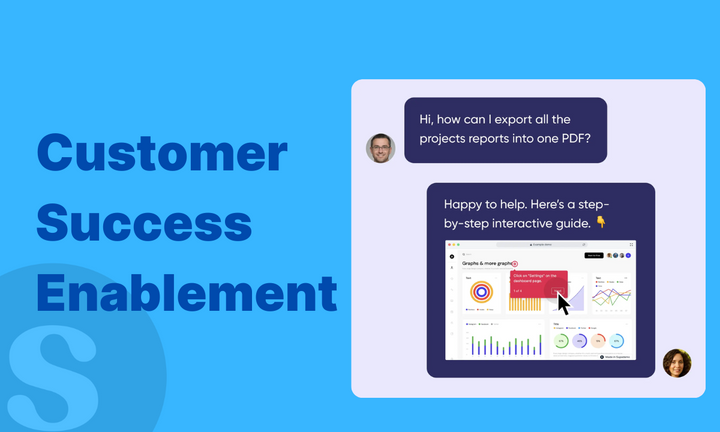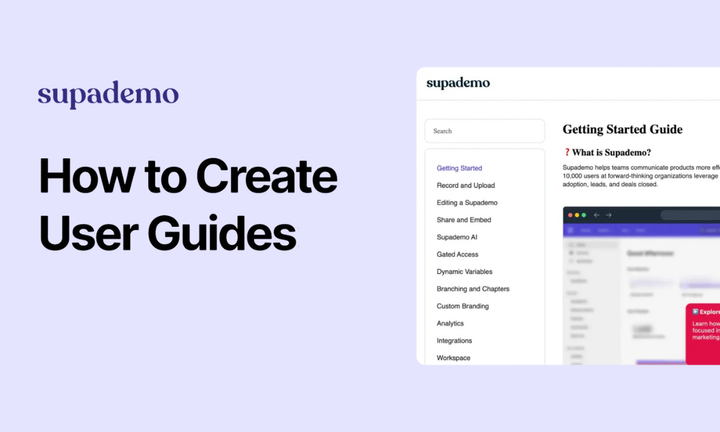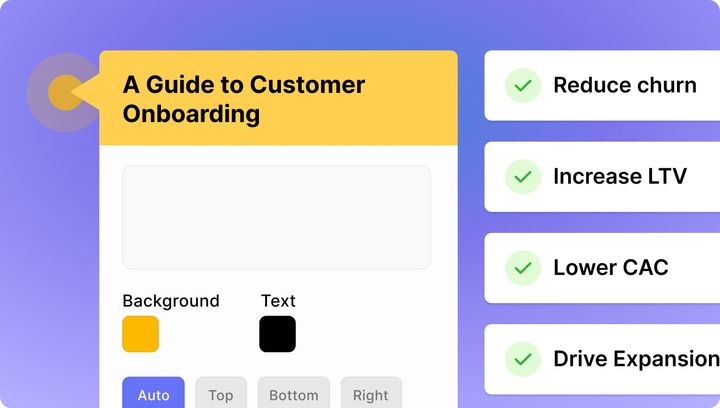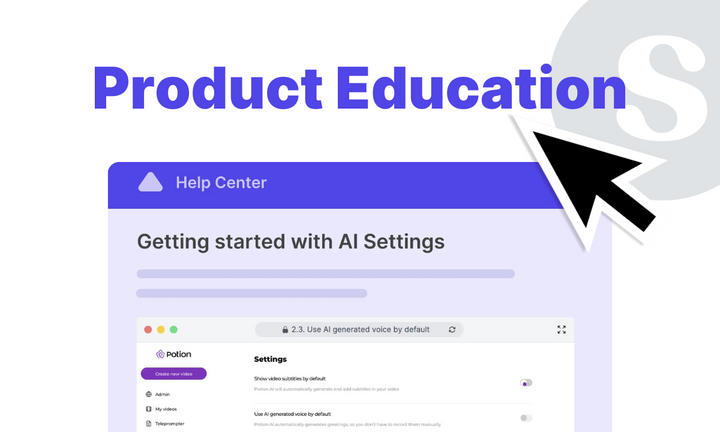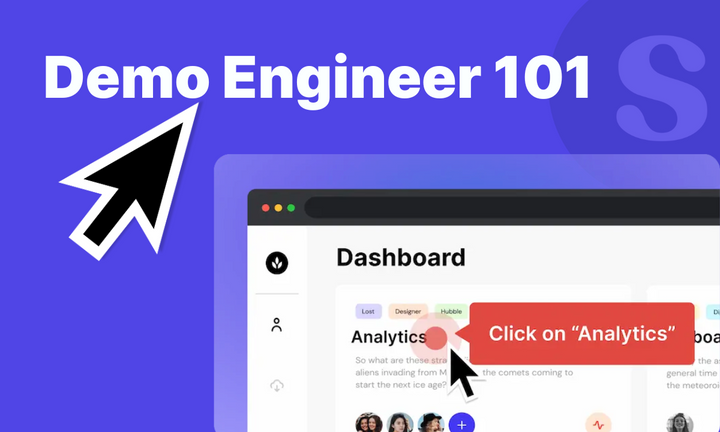Want better customer retention and less churn? Customer success enablement could be exactly what your SaaS business needs.
But what exactly is customer success enablement, and how can it help your customer-facing teams keep clients longer?
In this guide, you'll learn what customer success enablement is, why it matters for SaaS companies, and how to create an effective program that delivers real results.
What is customer success enablement?

Customer success enablement gives your CS team the training, resources, tools, and knowledge they need to help customers get real value from your product. It prepares your team properly so they can support your customers effectively.
Unlike sales enablement (which focuses on closing deals), customer success enablement focuses on post-sale activities that enhance product usage, retention, and expansion. While customer support reacts to problems, CS enablement prevents issues before they happen.
Customer success enablement covers the entire customer lifecycle, from initial customer onboarding through renewal and expansion. It creates systems that help CSMs deliver consistent experiences to every customer, regardless of experience level or product complexity.
Who handles customer success enablement?
The ownership of customer success enablement varies based on company size and structure:
1. Small companies (under 50 employees)
The CS leader (Director or VP) handles enablement alongside their other responsibilities. They create resources, run training sessions, and update playbooks weekly. This works when the team is small but becomes unsustainable as the company grows.
2. Mid-sized companies (50-200 employees)
A senior CSM or team lead owns enablement part-time. They dedicate 25-50% of their time to building team capabilities while still managing some customer accounts. These individuals leverage their direct customer experience to create effective enablement resources.
3. Large organizations (200+ employees)
Dedicated CS Enablement Manager roles take full ownership. These specialists focus 100% on improving team performance through structured training, resource creation, and measuring results. They coordinate across product, support, and customer success teams to ensure alignment.
No matter the company size, the most effective enablement programs involve frontline CSMs. They create resources for common scenarios, share best practices, and help onboard new team members based on their daily experience with customers.
Customer success enablement manager role
A CS Enablement Manager has specific responsibilities that drive team performance:
- Knowledge Gap Analysis - They conduct regular assessments to identify what CSMs need to know but currently don't.
- Content Creation - They build onboarding programs, playbooks, and training materials that standardize best practices.
- Training Coordination - They organize and lead sessions on product updates, process changes, and skill development.
- Resource Management - They maintain a central, organized library of all CS resources and ensure they stay current.
- Performance Tracking - They measure how enablement activities affect key metrics like CSM ramp time and customer satisfaction.
- Cross-Team Collaboration - They work with product teams to improve feature adoption and with sales to ensure smooth handoffs.
This role becomes increasingly crucial as companies scale and need consistency across larger teams with different experience levels.
Why does customer success enablement matter for SaaS?
For SaaS companies, good CS enablement directly affects your company's growth and retention in several key ways:
- Faster onboarding - CS teams with proper resources can get customers up and running more quickly, shortening time-to-value and improving early satisfaction. When CSMs have clear playbooks and interactive product demos for customer success, they can guide new users through your product more effectively.
- Lower churn - When your CS team has the right tools and knowledge, they notice at-risk accounts earlier and address issues before customers think about leaving.
- Better expansion revenue - Properly trained CS teams spot upsell and cross-sell opportunities more effectively, turning existing customers into sources of growth. They know when and how to introduce new features or higher-tier plans.
- Consistent customer experiences - With standardized processes and resources, every customer gets the same quality experience regardless of which CSM they work with. This consistency builds trust and strengthens your brand.
- Greater team productivity - When CSMs don't need to create new materials for each customer interaction, they can handle more accounts without sacrificing quality. Good enablement means less time creating custom resources and more time focusing on customer outcomes.
- Higher NPS and CSAT scores - Customers notice when your team knows what they're doing. This shows up directly in higher satisfaction metrics (Net Promoter Score and Customer Satisfaction scores) that you can share with prospects.
Key elements of a customer success enablement program
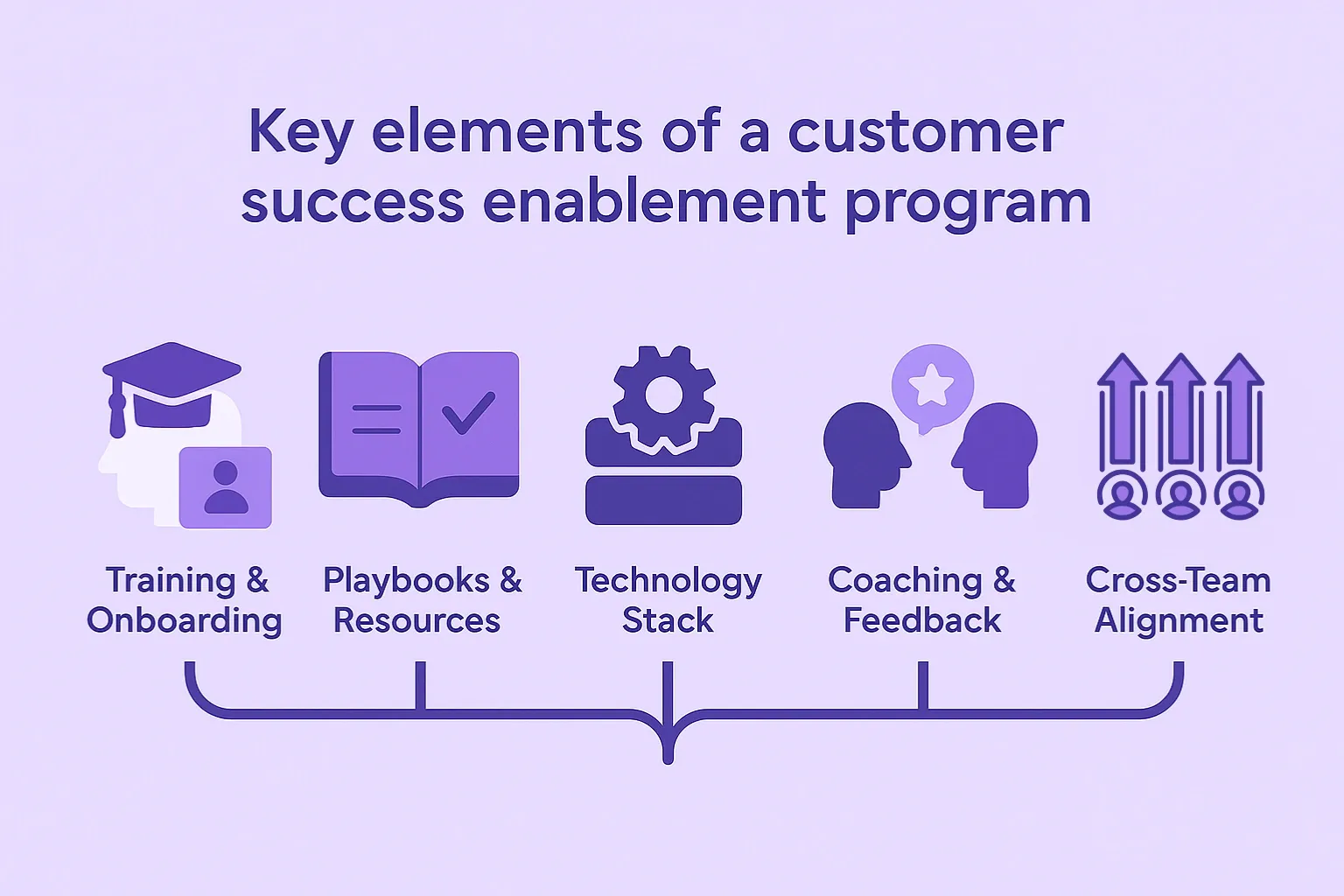
To build an effective customer success enablement program, you'll need several key components working together. Each element plays a specific role in helping your CS team deliver value to customers consistently.
Training & onboarding

Effective CS enablement starts with solid training for new team members. This includes:
- A clear onboarding process that covers your product, ideal customers, common use cases, and internal tools.
- Ongoing product training to keep the team updated on new features and updates.
- Practical skills development for difficult conversations, planning, and relationship building.
The best CS teams combine formal training with hands-on practice and shadowing opportunities where new CSMs can learn from experienced team members.
Playbooks & resources
Playbooks standardize how your team handles common customer situations, saving time and ensuring consistency. Key resources include:
- Onboarding playbooks that detail the steps for getting new customers started.
- Health check templates for regular account reviews.
- Renewal conversation guides.
- Escalation procedures for technical issues.
- Expansion and cross-sell conversation frameworks.
These resources should be living documents that evolve based on what works and what doesn't.
Technology stack
The right tools amplify your CS team's effectiveness. A typical CS enablement tech stack includes:
- Customer success platforms to track health scores and usage metrics.
- Interactive product demo software for creating guided tours.
- Knowledge bases for internal and customer-facing documentation.
- Video conferencing tools with recording capabilities.
- Communication platforms for staying connected with customers.
The best tech stack is one that helps CSMs focus on customers instead of administrative tasks.
Coaching & feedback
Even with great resources and tools, ongoing coaching makes the difference between good and great CS teams. To build a better coaching system include:
- Regular 1:1s between CSMs and managers to review accounts and strategy.
- Call reviews where teams can learn from successful (and challenging) customer interactions.
- Data-driven feedback based on customer health metrics and outcomes.
- Peer learning sessions where CSMs share best practices and solve problems together.
Effective coaching helps CSMs continue to grow while applying what they've learned in training.
Cross-team alignment
Customer success doesn't happen in isolation. Alignment with other teams is essential. Make sure to establish:
- Regular syncs with product teams to share customer feedback and learn about upcoming features.
- Clear handoff processes from sales to customer success.
- Shared customer insights with marketing to develop relevant content.
- Feedback loops with support to identify trending issues.
When teams work together, customers experience a unified company rather than disconnected departments. Ensuring a seamless omni-channel experience for enhanced customer success requires this alignment.
Steps to build a customer success enablement program
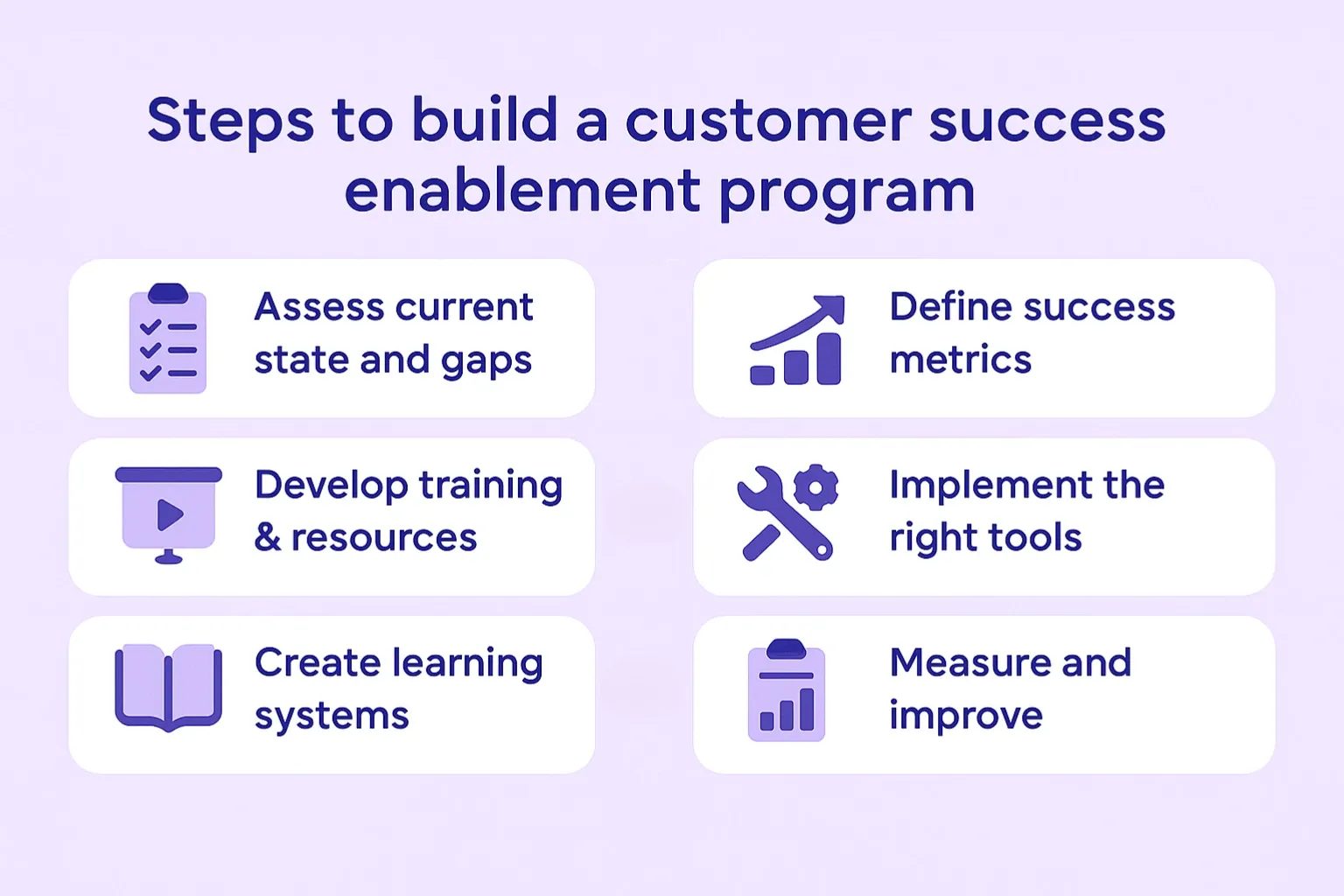
Creating an effective CS enablement program takes planning and iteration. Here's a detailed roadmap to get you started:
1. Assess current state and gaps
Start by understanding where your CS team stands today:
- Survey your CS team about their biggest challenges and resource needs.
- Review customer feedback and common support tickets.
- Analyze key customer success metrics like time-to-value, retention rates, and account expansion.
- Identify your most successful CSMs and what makes them effective.
This assessment reveals which enablement areas need the most attention. For example, if customers frequently ask the same product questions, focus on creating better product guides. If handoffs from sales to CS cause friction, start by fixing that process.
Create a simple scorecard rating different aspects of your CS operation (onboarding, training, resources, tools) on a 1-5 scale to identify the weakest links.
2. Define success metrics
Before building your program, decide how you'll measure success:
- CSM ramp time (how quickly new hires become productive).
- Customer NPS and CSAT scores.
- Retention and expansion rates.
- Product adoption metrics.
- CSM efficiency (accounts per CSM, time spent per account).
These metrics will help you track the impact of your enablement efforts.
Start small - pick 2-3 metrics most relevant to your biggest challenges. For a new program, CSM ramp time and customer satisfaction make good starting points.
3. Develop training & resources
Based on your assessment, create the resources your team needs most:
- Build a comprehensive onboarding program for new CSMs.
- Create playbooks for key customer touch points.
- Develop interactive product demos for common customer use cases.
- Design scenario-based training for handling difficult situations.
For example, create a detailed onboarding playbook that covers everything from welcome emails to 30/60/90-day check-ins. Or develop interactive demos that show customers how to accomplish specific tasks in your product.
Start with a "minimum viable library" - identify the top 5 processes that would benefit most from standardization and create those resources first. For most teams, these include customer onboarding, quarterly business reviews, renewal conversations, and handling common technical questions.
4. Implement the right tools
Select and implement tools that support your enablement strategy:
- Customer success platforms like Gainsight or ChurnZero for tracking customer health.
- Interactive demo software for creating guided product tours.
- Knowledge base solutions for organizing internal resources.
- Learning management systems for delivering and tracking training.
Choose tools that integrate with each other to create a seamless workflow for your team.
Do a tools audit first. Companies often already have useful tools that aren't being fully utilized. Get full value from what you already have before investing in new solutions. Add customer success Chrome extensions to make your team more efficient.
5. Create learning systems
Set up ways for ongoing knowledge sharing and improvement:
- Schedule regular training sessions for product updates and new features.
- Set up mentoring where experienced CSMs help newer team members.
- Create channels for sharing customer success stories and challenges.
- Recognize CSMs who contribute to the enablement program.
Set aside 15-30 minutes in team meetings for "knowledge sharing" where CSMs present a recent customer win, a useful resource they created, or a challenging situation they resolved. Record these sessions as content for your enablement library.
6. Measure and improve
Once your program is running, track its impact and make improvements:
- Monitor your CSM ramp time, customer satisfaction scores, retention rates, and product adoption.
- Gather feedback from CSMs on which resources are most helpful.
- Check in with customers about their experience with your team.
- Make regular updates to playbooks and resources based on what you learn.
Create a quarterly enablement review to assess what's working, what's not, and what needs updating. Keep enablement resources in an easily editable format so they evolve with your team's needs.
Best practices for customer success enablement
After exploring what CS enablement is and how to build a program, let's look at some proven strategies that will help your efforts succeed:
- Personalize enablement by role and experience level - New CSMs need different resources than veterans. Create learning paths that match each team member's needs and experience.
- Use interactive content whenever possible - Static documents are often skimmed or ignored. Interactive demos, videos, and quizzes improve engagement and retention.
- Create a central hub for all resources - CSMs waste time when they have to hunt for information. A well-organized knowledge base or intranet makes resources easy to find.
- Encourage knowledge sharing among team members - Some of the best enablement happens peer-to-peer. Create forums where CSMs can share tips and ask questions.
- Align enablement with customer journeys - Organize resources around the customer lifecycle rather than internal processes to ensure they're truly customer-centric.
- Update resources regularly - Outdated playbooks are worse than no playbooks. Set a schedule for reviewing and refreshing enablement materials.
- Involve CSMs in creating enablement resources - They know what they need best. Plus, involvement creates buy-in and improves adoption.
- Automate repetitive tasks - Use technology to handle routine communications and updates, freeing CSMs to focus on high-value activities.
Real-world examples of customer success enablement
Let's look at how three different companies implemented customer success enablement to solve specific challenges. These examples show how CS enablement works across different company sizes and industries.
Case study 1: Textable - Driving CS enablement at scale
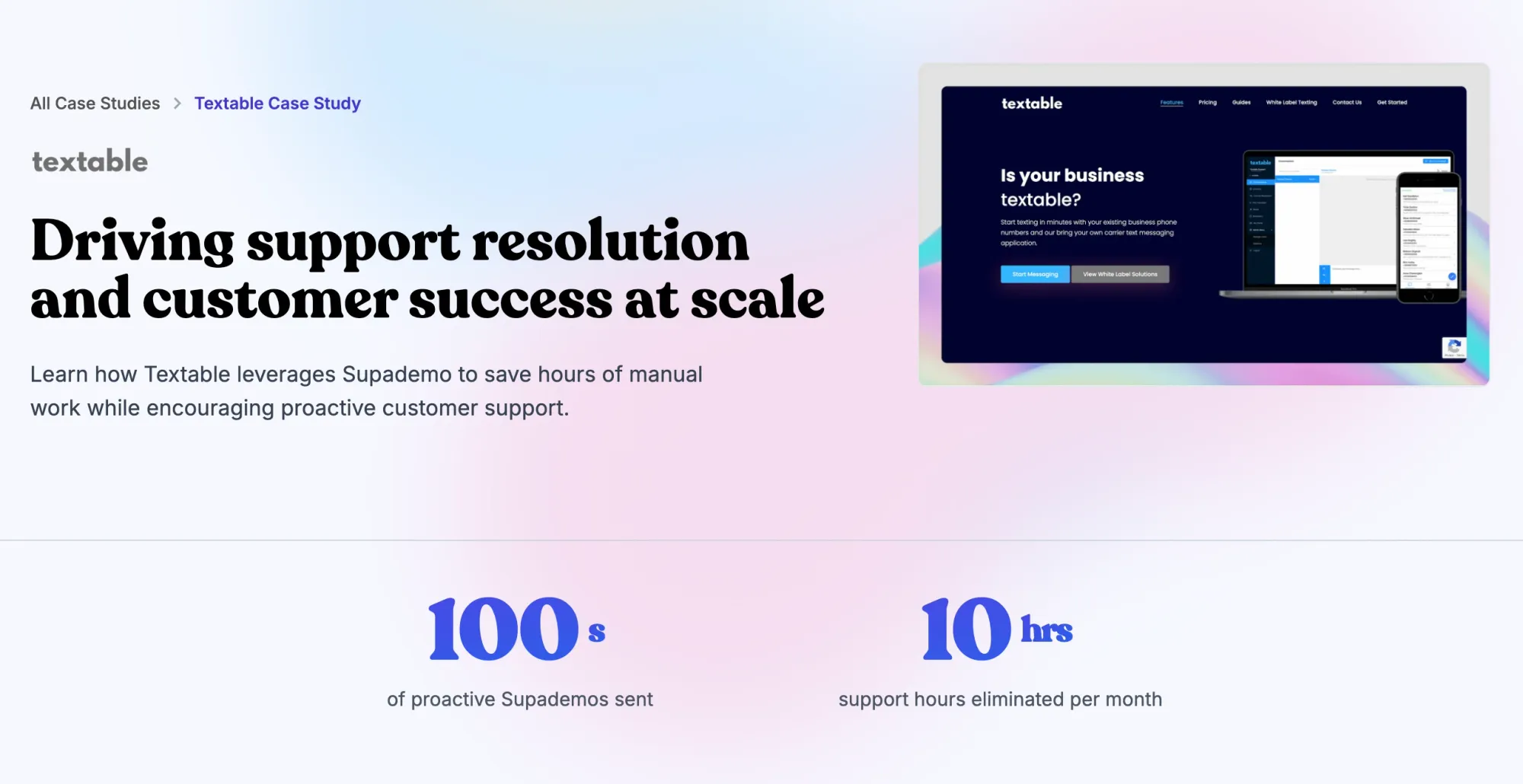
Textable, a VoIP text messaging platform for businesses and Managed Service Providers with 10-50+ employees, faced significant challenges with their customer success operations. Their small team was overwhelmed by repetitive support tickets that hindered growth and innovation.
Their customer success enablement strategy centered on:
- Creating hundreds of proactive, interactive product demos using Supademo for common customer questions.
- Developing multi-demo showcases tailored to different customer personas and maturity levels.
- Implementing a system where CS team members could quickly create custom walkthroughs for specific customer issues.
- Integrating these visual guides into their support workflow.
The results were remarkable. Textable eliminated over 100 hours of support time monthly and saved approximately 10 hours per week previously spent on redundant tasks. This allowed their CS team to refocus on strategic initiatives and improve overall customer satisfaction.
Case study 2: RareCircles - Enhancing CS quality during product evolution
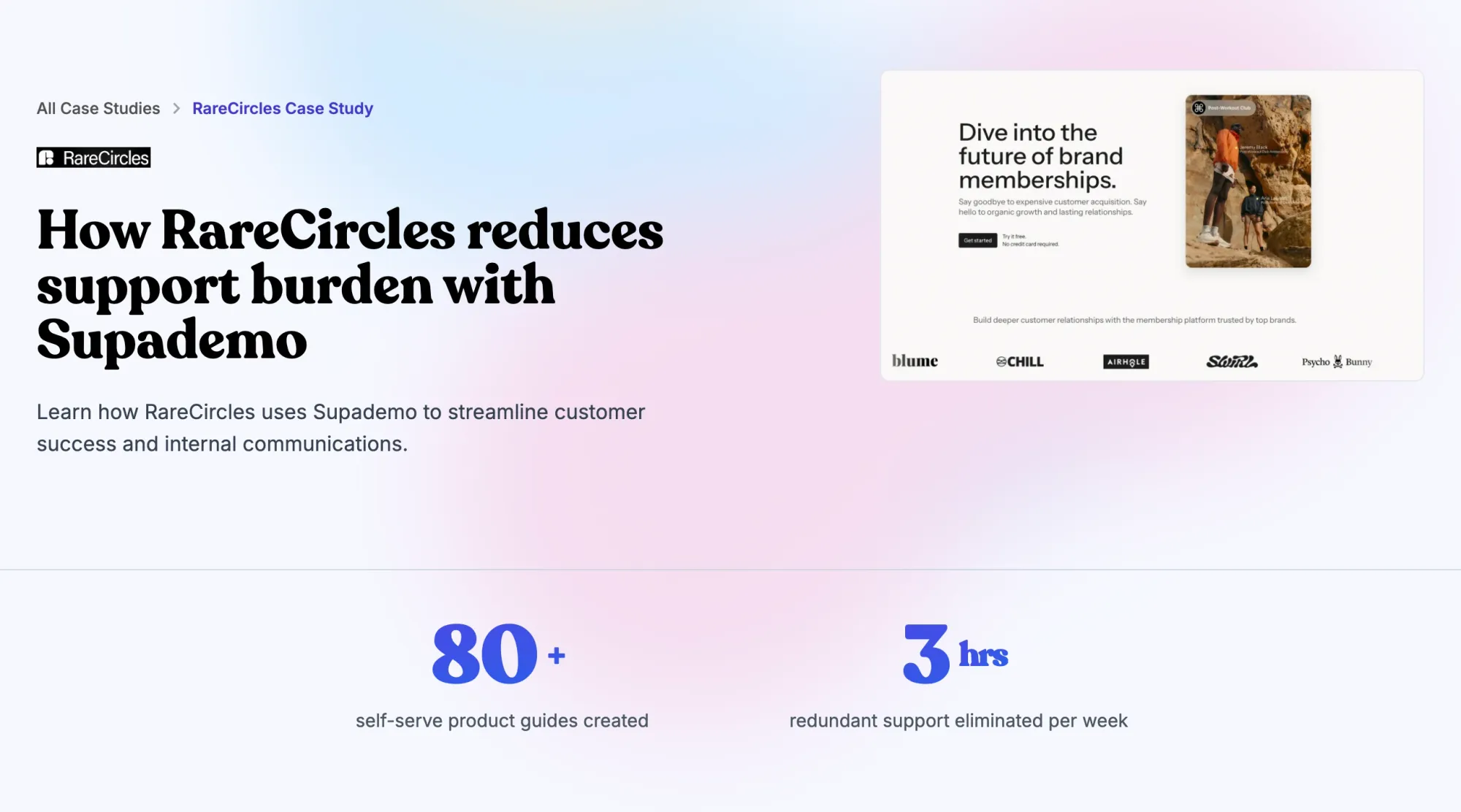
RareCircles, a community and engagement platform for forward-thinking brands with 11-50 employees, struggled with CS consistency and knowledge management, especially during a major product pivot from Web3 to Web2.
Their CS enablement program focused on:
- Building over 80 self-serve product guides for customer use.
- Creating a complete, visual knowledge base for their CS team.
- Developing specific visual documentation with the help of Supademo for handling common support questions.
- Implementing standardized internal communication channels for sharing product knowledge.
This approach saved RareCircles approximately 3 hours per week in redundant support work. More importantly, it improved the quality and effectiveness of their customer service by ensuring consistent information delivery.
The interactive nature of their guides made support documentation more engaging for customers, while the ease of creating and updating materials proved invaluable during their product transition phase.
Final thoughts
Customer success enablement is essential for SaaS companies that want to grow and keep their customers. When done well, it creates a positive cycle: well-prepared CSMs create successful customers, who stay longer and spend more.
Start small by fixing your biggest problems. For instance, if onboarding isn't consistent, create a standard playbook. If customers struggle to use key features, build interactive demos that show them how. Small improvements add up to big results over time.
It is also worth noting that enablement is an ongoing process, not a one-time project. As your product changes and your customer base grows, your enablement needs will change too. Stay flexible and keep improving.
Ready to improve your customer success enablement? Try Supademo for free to create interactive product demos that help your CS team onboard and educate customers more effectively.
FAQs
How is CS enablement different from sales enablement?
Sales enablement focuses on helping teams close new deals while CS enablement concentrates on post-sale activities that drive retention and expansion. Both are important, but they serve different stages of the customer journey.
What tools are essential for CS enablement?
The main tools include a customer success platform, interactive demo software, a knowledge base, and communication tools. Start with the basics and add specialized tools as your program grows.
How do you measure the impact of enablement?
Track metrics like CSM ramp time, retention rates, NPS scores, and expansion revenue. Compare these metrics before and after implementing enablement initiatives to quantify your impact.
How often should enablement resources be updated?
Review main resources quarterly and update them whenever there are significant product changes or new customer insights. Outdated resources can do more harm than good by providing incorrect information.


